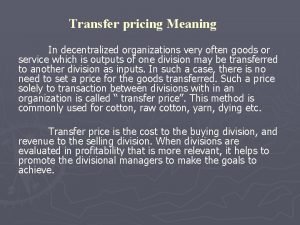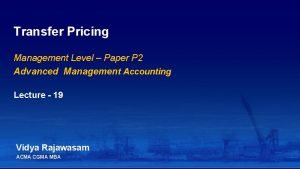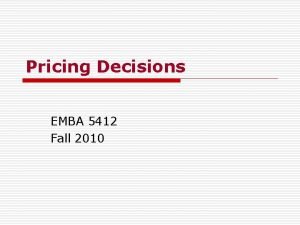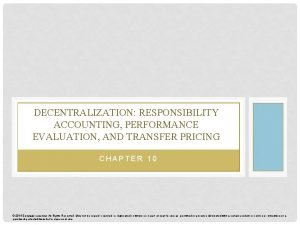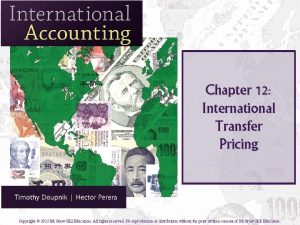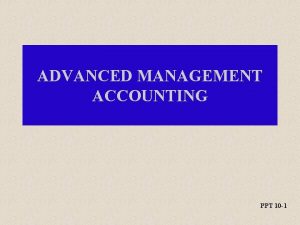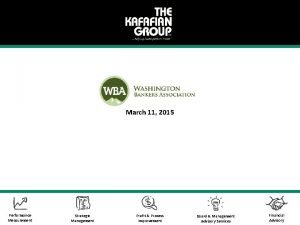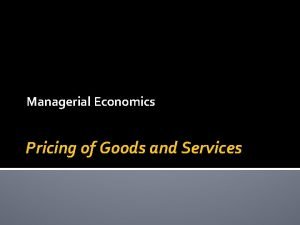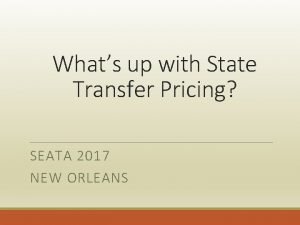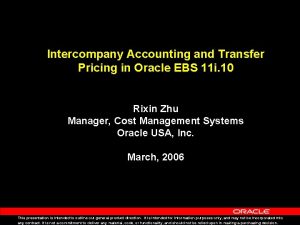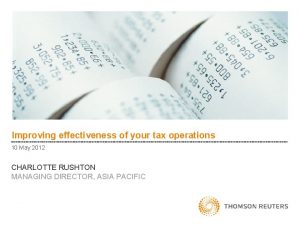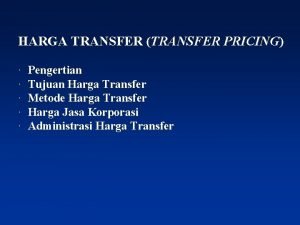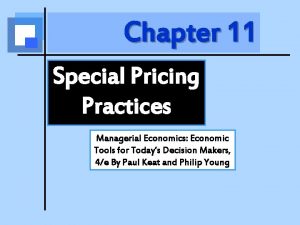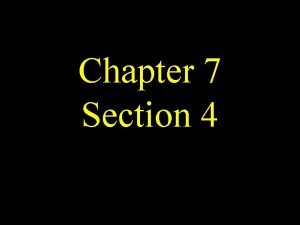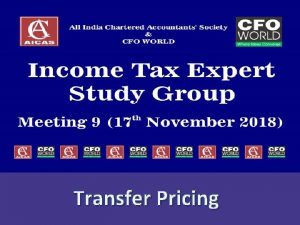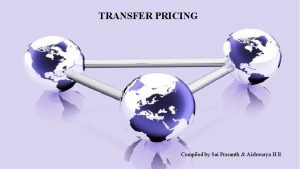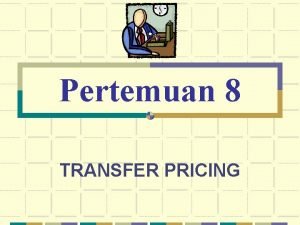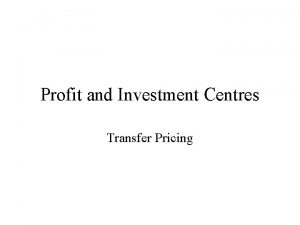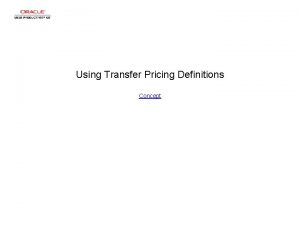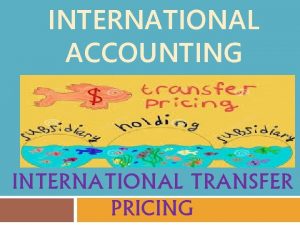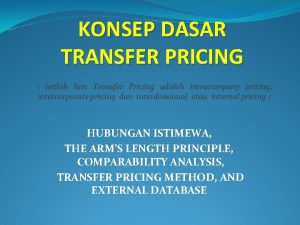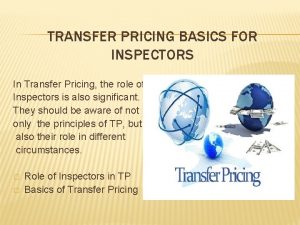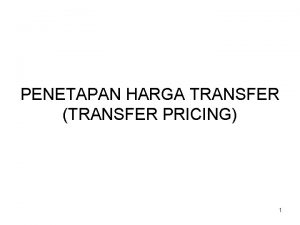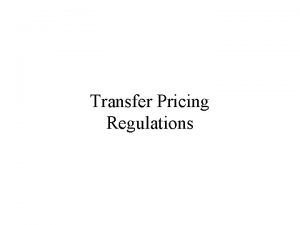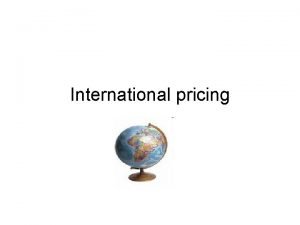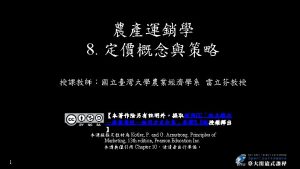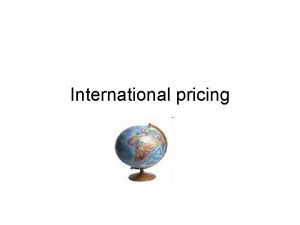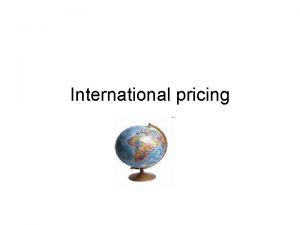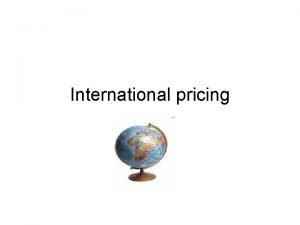Transfer Pricing Mark FieldingPritchard 1 Why Does TP






















- Slides: 22

Transfer Pricing Mark Fielding-Pritchard 1

Why Does TP Have a Bad Name Basic Scheme Tax in UK is 30%, Tax in India is 40% Markov makes bicycles in Scotland which cost $5, sells in India for $25 What should be the transfer price? What if Markov Scotland sells to Markov in Far Away (an offshore zone with tax rate 1% for $6 and MFFA sells on to in India for $24? So tax authorities treat transfer pricing very seriously; and most developing companies have no concept of group relief so even transfers inside the country between group companies will be subject to TP investigations 2

Transfer Pricing For P 5 remember ethical considerations Good transfer price will have elements of Goal congruence Fairness Autonomy Bookkeeping Minimise tax In a perfect market transfer price will be market price 3

Transfer Price when Seller Has Surplus Capacity Transfer price negotiated Max price buyer will pay is lower of External purchase price Min price seller will take is marginal cost Selling price minus marginal cost 4

Transfer Price when Seller Has No Surplus Capacity Transfer price negotiated Max price buyer will pay is lower of External purchase price Min price seller will take is marginal cost + lost contribution Selling price minus marginal cost 5

Practical Methods Market Based Use market price as adjusted for differences Cost Based Cost + Standard cost Marginal cost Full cost Opportunity cost 6

Other Methods Marginal Dual cost plus a lump sum pricing 7

Q 49 SSA a) Goal congruence Fairness Autonomy Minimise Bookkeeping tax 8

Q 49 SSA b) Division A is currently producing 150000 units, therefore there is spare capacity of 10000 units Contribution per unit Knee Ankle Elbow Wrist Competitor Ankle 14 8 10 5 6 9

Q 49 SSA b) For quotation 1 A has spare capacity so we should manufacture Transfer price should be variable cost + negotiation (VC=7) Anticipated TP is $10. 50 which is higher than $9. Division B will buy from competitor so use $9 or some negotiated number For quotation 2 first 10000 should be at variable cost + negotiation, For 8000 it is better to stop producing wrists and manufacture ourselves I would recommend 18000 units at $9 10

Q 49 SSA b) Overall principle is to maximise group profit Increased sales of ankle units first 10000 units will increase profits by $80000 Contribution per unit is $8 if manufactured and $6 if bought, as wrists generated $5 we should cut wrists and boost ankles Transfer price needs to be not more than $9 to make it advantageous for B 11

Q 49 SSA b) Transfer Price $10. 5 A Sales Price 10. 5 Cost 7 Contribution 3. 5 18000 units 63000 Tax (40/20/20%) 25200 B 15 10. 5 4. 5 81000 16200 Competitor 15 9 6 108000 21600 After Tax Income 102600 86400 12

Q 49 SSA b) Transfer Price $9 A Sales Price 9 Cost 7 Contribution 2 18000 units 54000 Tax (40/20/20%) 21600 B 15 9 6 108000 21600 Competitor 15 9 6 108000 21600 After Tax Income 118800 86400 13

Q 55 Landual lamps a) What to write? In general some theory and some specifics Therefore what makes up good TP policy? Goal congruence, Fairness, Autonomy Bookkeeping Minimise tax Housing- costs Electrical- market prices 14

Q 55 Landual lamps a) Housing- costs Electrical- market prices Electrical earns 1557 - 804 -370= 383 However adverse variance of 575 k probably means that Electrical is not profitable 15

Q 55 Landual lamps a) Housing is based on 8204 + 6902 As full actual costs there is no pressure to reduce costs No allocated cost is covered 16

Q 55 Landual lamps b) The change is from all costs to variable costs Usually where there are intricate designs overhead is an important component of costs so this would not seem logical without more information 17

Value For Money- Non For Profits No readily available scale exists How to compare costs and benefits Timescales Externalities 18

Value For Money 3 Es Economy Effectiveness Efficiency 19

Value For Money Goal Systems Resources Internal Processes 20

Value For Money- Problems Diverse objectives Multiple objectives Politics Benchmarking (&league tables) 21

Value For Money-Target Setting Central control Difficulty level All or nothing Too many targets Inappropriate targets Cost Ownership Gaming Conflict 22
 Pictures
Pictures Role of transfer pricing in a decentralized company
Role of transfer pricing in a decentralized company Transfer pricing example
Transfer pricing example Transfer pricing examples
Transfer pricing examples Responsibility accounting and transfer pricing
Responsibility accounting and transfer pricing Transfer pricing example
Transfer pricing example Importance of transfer pricing
Importance of transfer pricing Role of management accounting ppt
Role of management accounting ppt Roe vs roi
Roe vs roi Pricing methods in managerial economics
Pricing methods in managerial economics Multi-state transfer pricing analysis
Multi-state transfer pricing analysis Oracle transfer pricing
Oracle transfer pricing Guidance on transfer pricing aspects of intangibles
Guidance on transfer pricing aspects of intangibles Transfer pricing
Transfer pricing Global transfer pricing survey
Global transfer pricing survey Wu transfer pricing center
Wu transfer pricing center Pengertian transfer pricing
Pengertian transfer pricing Transfer pricing in managerial economics
Transfer pricing in managerial economics Dont ask
Dont ask Does the table represent a function why or why not
Does the table represent a function why or why not What does the image represent
What does the image represent Is a disturbance that transfers energy
Is a disturbance that transfers energy How does predatory pricing hurt competition
How does predatory pricing hurt competition

